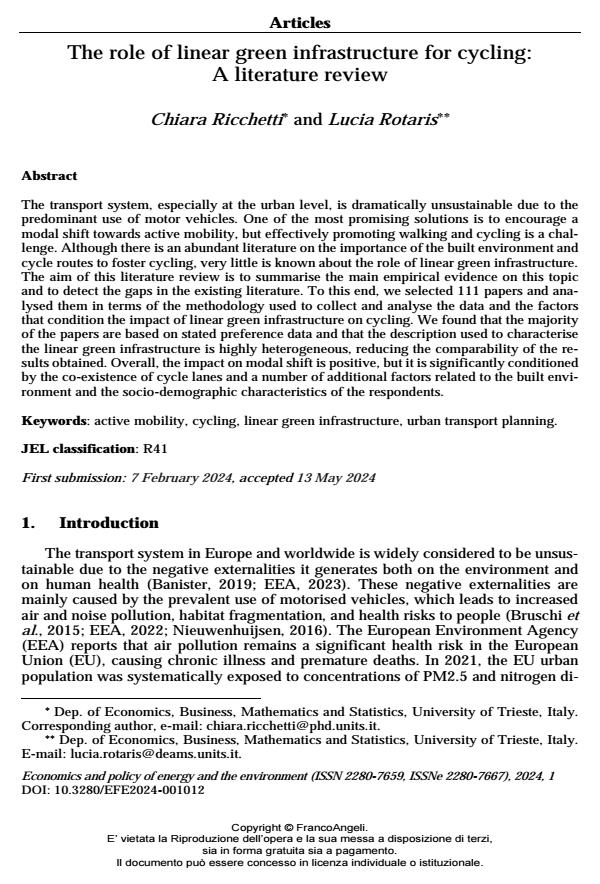The role of linear green infrastructure for cycling: A literature review
Journal title ECONOMICS AND POLICY OF ENERGY AND THE ENVIRONMENT
Author/s Chiara Ricchetti, Lucia Rotaris
Publishing Year 2024 Issue 2024/1
Language English Pages 38 P. 219-256 File size 308 KB
DOI 10.3280/EFE2024-001012
DOI is like a bar code for intellectual property: to have more infomation
click here
Below, you can see the article first page
If you want to buy this article in PDF format, you can do it, following the instructions to buy download credits

FrancoAngeli is member of Publishers International Linking Association, Inc (PILA), a not-for-profit association which run the CrossRef service enabling links to and from online scholarly content.
The transport system, especially at the urban level, is dramatically unsustainable due to the predominant use of motor vehicles. One of the most promising solutions is to encourage a modal shift towards active mobility, but effectively promoting walking and cycling is a chal- lenge. Although there is an abundant literature on the importance of the built environment and cycle routes to foster cycling, very little is known about the role of linear green infrastructure. The aim of this literature review is to summarise the main empirical evidence on this topic and to detect the gaps in the existing literature. To this end, we selected 111 papers and ana- lysed them in terms of the methodology used to collect and analyse the data and the factors that condition the impact of linear green infrastructure on cycling. We found that the majority of the papers are based on stated preference data and that the description used to characterise the linear green infrastructure is highly heterogeneous, reducing the comparability of the re- sults obtained. Overall, the impact on modal shift is positive, but it is significantly conditioned by the co-existence of cycle lanes and a number of additional factors related to the built envi- ronment and the socio-demographic characteristics of the respondents.
Keywords: active mobility, cycling, linear green infrastructure, urban transport planning
Jel codes: R41
- What drives university students to cycle? An investigation of their motivations Chiara Ricchetti, Lucia Rotaris, Mariangela Scorrano, in International Journal of Sustainable Transportation /2025 pp.211
DOI: 10.1080/15568318.2025.2455010
Chiara Ricchetti, Lucia Rotaris, The role of linear green infrastructure for cycling: A literature review in "ECONOMICS AND POLICY OF ENERGY AND THE ENVIRONMENT" 1/2024, pp 219-256, DOI: 10.3280/EFE2024-001012